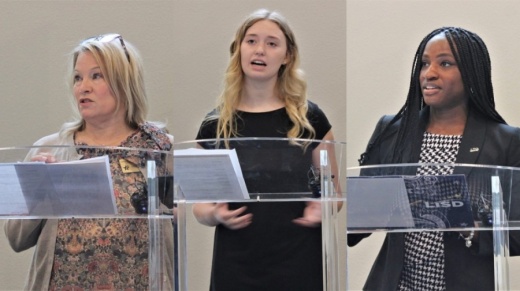In a news conference April 27 in Grapevine, educators, parents, business owners and students spoke in favor of continuous support of House Bill 3, which was passed in 2019 and reformed school finance. They also spoke in support of continuing district funding based on historical enrollment data rather than current numbers affected by the COVID-19 pandemic. Those in attendance also wanted to ensure federal stimulus funds allocated for Texas public schools get distributed.
"This support will empower schools to provide for their students, our future workforce that all of our businesses need and ultimately contribute to our thriving state of Texas economy," North Texas Commission President Chris Wallace said. The NTC is a public-private partnership of business, local governments, chambers of commerce and other organizations. "There's an estimated $17.9 billion currently designated for public education in the state of Texas. These funds could use be used to offset COVID-19-related expenditures and address learning loss created by this pandemic."
Among those in attendance was Grapevine-Colleyville ISD trustee Coley Canter, who said the additional money will be crucial in helping students succeed academically and recover from the pandemic's effects.
“We're going to have to customize that learning, and it's going to require additional staff, and then additional counseling and support, mental health staff, social workers, things of that nature, to support the social-emotional needs of kids,” Canter said. “I think this is also an opportunity in education to leverage all the ways we can impact students.”
On March 11, President Joe Biden approved $1.9 trillion in federal stimulus funding, about $12.4 billion of which was allocated for Texas schools, according to Raise Your Hand Texas, a public policy group that supports solutions that invest in students, encourage innovation and autonomy as well as improve college and workforce readiness. That is in addition to the $5.5 billion allocated to Texas schools in the second round of stimulus funding that has not yet been distributed.
The COVID-19 pandemic has raised concerns about the learning gap among students. Many experts fear students are falling behind in their classes in both remote and in-person settings.
“There's very little motivation for students to do their best,” said Lauren Abell, a junior in Grapevine-Colleyville ISD. “I think that teachers next year are going to have to deal with how can we go back and teach students different things they should have learned this past year. And they're going to need the time both in and outside of class to be able to do that.”
Alexis Miller, a third-grade teacher at Southridge Elementary School in Lewisville ISD, said investing in the recovery of Texas public schools helps not only the students but also the local economy.
“A sense of urgency is needed to meet the needs of our school communities so that our efforts are proactive and contribute to closing the gaps that currently exist,” Miller said. “You know, we're not only thinking about our recovery. We're also thinking about our future, too.” According to data provided by Raise Your Hand Texas, many school districts have yet to receive the majority of funding allocated to them in the three federal stimulus rounds.
Raise Your Hand Texas estimates that Lewisville ISD is missing more than $55 million of the $59 million in eligible stimulus funds while Grapevine-Colleyville ISD is estimated to be missing more than $16 million of the over $17 million in stimulus funds for which it is eligible.
"The dollars sent to each school district throughout Texas are not just education dollars," Wallace said. "They are jobs dollars. They are local tax dollars, and most importantly, they are Texas dollars. I know many of my chamber of commerce partners are here as well. We all will tell you that our economic stability and our strength of our state's economy begins with quality education."





